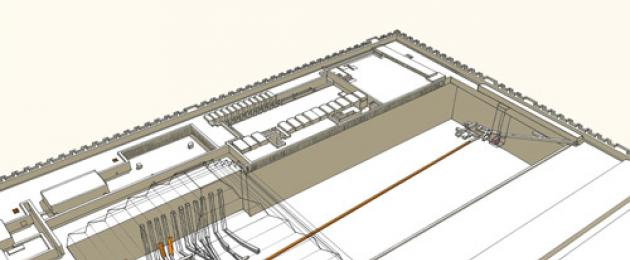Pyramid shape
This six-step pyramid (measuring 125 by 115 m and approximately 62 m high) was the first pyramid in Ancient Egypt. To this day, the pyramid of Djoser has been preserved in good condition, although over the past millennia it has been somewhat covered with sand, so that its dimensions today are 121 × 109 m and its height is 61 m. The styles and shapes found during the construction of this pyramid have become role model and further development stone construction not only in Ancient Egypt, but also in other regions of the ancient world.
Data
Location of Saqqara
Customer Djoser (Necherikhet)
Construction time 3rd Dynasty (c. 2650 BC)
Type Step pyramid
Base size 121 × 109 m
Height (originally) 62.5 m
Height (today) 62 m
Volume 330400 m³
Cult pyramid
Southern subsidiary pyramid. Plan. Step Pyramid of Djoser .
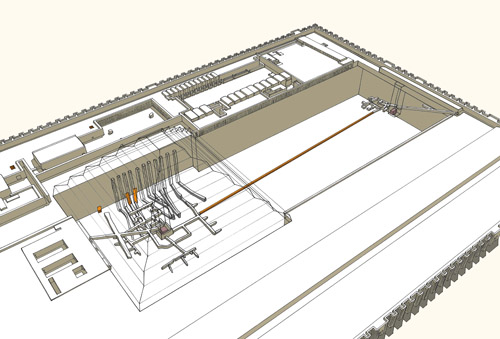
Connection of the southern pyramid with the pyramid of Djoser. Plan .
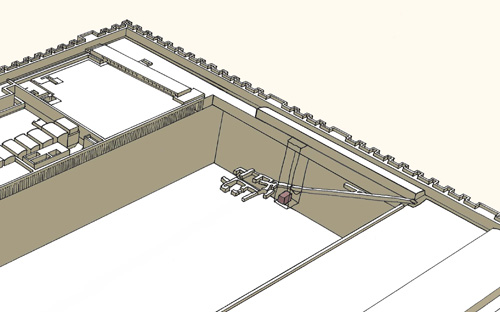
Plan of the underground structures of the southern pyramid. Djoser's pyramid complex.

Plan of the underground premises of the southern pyramid. Pharaoh Djoser. Funeral complex.
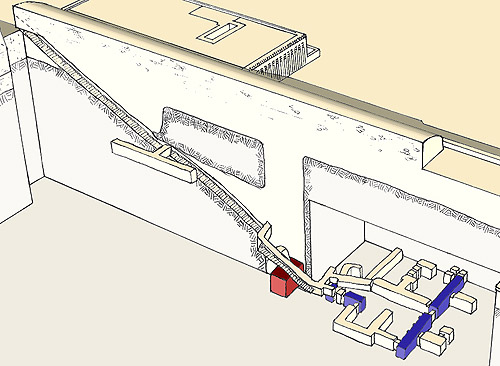
Plan of the underground galleries of the auxiliary pyramid of Djoser. Saqqara.
Construction
The architect of Djoser's pyramid, according to ancient Egyptian tradition, is considered to be the highest dignitary (chati) of Djoser, Imhotep. Imhotep is considered extremely wise man, gifted with many talents - teacher, doctor, astronomer and priest. His high position in the king's court is described on the basis of a statue of Djoser, where the titles of the pharaoh are followed by the titles of Imhotep: "keeper of the treasury of the king of Lower Egypt, first after the king in Upper Egypt, steward of the great palace, chief priest of Heliopolis, Imhotep, builder, architect, stone sculptor VAZ". Imhotep was later deified, and in the Late and Classical period, Imhotep was revered as the god of architecture and medicine, and the Greeks associated him with their god of medicine, Asclepius. Pilgrims visited Saqqara, where Imhotep, whose tomb was never discovered, was likely to be buried. At Saqqara there are burial sites of mummies of ibises, a bird associated with both Imhotep and Thoth, the god of wisdom, writing and science. Ibis mummies were buried by the thousands in an animal necropolis northeast of the step pyramid complex.
External wall of the complex. Step pyramid of Djoser.

Entrance door to the Djoser pyramid complex.
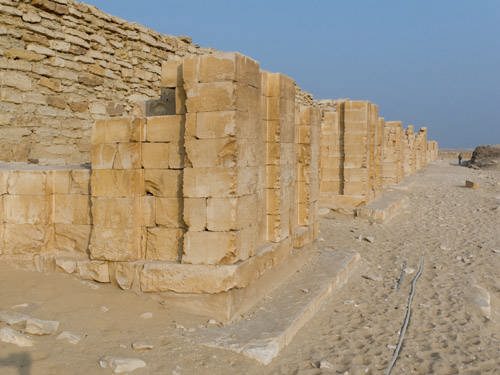
Southern part of the outer wall of the Pyramid of Djoser. Funeral complex.
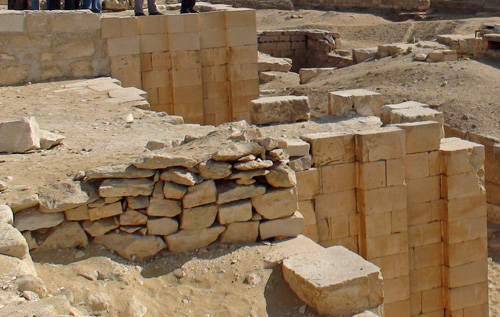
External wall. View from above. Pharaoh Djoser. Funeral complex.
Initially, Imhotep planned to create an ordinary stone mastaba (rectangular tomb; translated from Arabic as “bench”). Only during the construction process did it turn into the first step pyramid. The meaning of the steps is thought to be symbolic - along them the deceased pharaoh was supposed to ascend to heaven. But from the very beginning it was different from previous mastabas, since stone was used as a building material, rather than raw brick. Construction took place in six stages, according to the number of steps. It is possible that the core of the tomb, made of limestone blocks, was built for Djoser’s brother Sanakht. As a result of the superstructures, the base of the pyramid reached dimensions of 125 × 115 meters and a height of 61 meters.
Entrance colonnade. Step pyramid of Djoser.
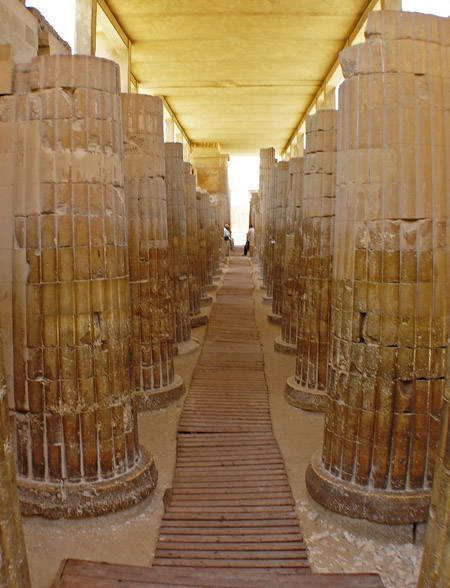
Entrance buttresses with columns. Djoser's pyramid complex.

The stone ceiling imitates palm logs. Pharaoh Djoser. Funeral complex.
The design of the pyramid has a feature that was not later found in the pyramids of the pharaohs - a vertical shaft gigantic in width and depth, with a unique huge sarcophagus made of granite “sleepers”. The shaft is covered on top with a dome. The sarcophagus has a round hole at the top with a plug, which makes it similar to Neolithic dolmens, and rests on the ruins of some marble structure, which was decorated with carvings in the form of stars. The origin of these debris is the object of close study by archaeologists, since it is believed that the sarcophagus in its current very good condition could have been assembled on the debris, but not on the structure that later collapsed.
The pyramid was robbed in ancient times, and there are several different holes made by the robbers.
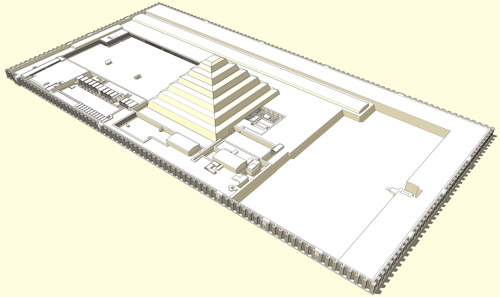
Reconstruction of the burial complex. Pyramid of Pharaoh Djoser. Saqqara.

Plan of the Djoser pyramid complex. 1- pyramid of Djoser, 2- entrance to the burial complex,
3- side passage to the southern part of the courtyard kheb-sed, 4- royal pavilion (Temple T),
5 - room with four double columns, 6 - southern house, 7 - northern house, 8 - mortuary temple,
9 - auxiliary southern pyramid, 10 - entrance colonnade, 11 - room with a frieze of cobras,
12 - courtyard, 13 - B-shaped bases, 14 - Sais southern passage to underground galleries,
15 - altar, 16 - seb-khed celebration courtyard, 17 - serdab with a statue of Djoser, 18 - passage on the west side,
19 - external wall of the complex.
Purpose of the pyramid
The pyramid of Djoser was intended for the entire family of the deceased, like the early mastabas. In later pyramids, only one king was buried. In the pyramid of Djoser, 11 burial chambers were prepared for family members in the tunnels of the pyramid. All his wives and children were buried there, including the mummy of a child approximately eight years old. The body of Djoser himself was not found (probably only his mummified heel remained). (Robbers of that time often set mummies on fire in order to extract from the ashes gold amulets, which were necessarily used in its manufacture.)
| Data | |
|---|---|
| Location | Saqqara |
| Customer | Djoser (Necherikhet) |
| Construction time | 3rd Dynasty (c. 2650 BC) |
| Type | Step pyramid |
| Base size | 121 × 109 m |
| Height (original) | 62.5 m |
| Height (today) | 62 m |
| Volume | 330400 m³ |
| Cult pyramid | |
Step pyramid at Saqqara- the oldest surviving large stone building in the world. Built by the architect Imhotep in Saqqara for the burial of the Egyptian pharaoh Djoser c. 2650 BC e. The core of the tomb is made of limestone blocks. The size of the pyramid is 125 meters × 115 meters and its height is 61 meters.
Encyclopedic YouTube
1 / 2
Treasures of Saqqara 2/2 [DocFilm]
Pyramid of Djoser. Imhotep
Subtitles
Pyramid shape
This six-step pyramid (measuring 125 m by 115 m and approximately 62 m high) was the first pyramid in Ancient Egypt. To this day, the pyramid of Djoser has been preserved in good condition, although over the past millennia it has become somewhat covered with sand, so that its dimensions today are 121 m × 109 m and its height is 61 m. The styles and forms found during the construction of this pyramid are became a role model for the further development of stone construction not only in Ancient Egypt, but also in other regions of the ancient world.
Construction
The architect of Djoser's pyramid, according to late Egyptian tradition, is considered to be the highest dignitary (chati) of Djoser, Imhotep. Initially, Imhotep planned to create an ordinary stone mastaba (rectangular tomb; translated from Arabic as “bench”). Only during the construction process did it turn into the first step pyramid. The meaning of the steps is thought to be symbolic - along them the deceased pharaoh was supposed to ascend to heaven. But from the very beginning it was different from previous mastabas, since the building material here was stone rather than raw brick. Construction took place in six stages, according to the number of steps. It is possible that the core of the tomb, made of limestone blocks, was built for Djoser’s brother Sanakht. As a result of the superstructures, the base of the pyramid reached dimensions of 125 meters × 115 meters and a height of 62 meters.
The design of the pyramid has a feature that was not later found in the pyramids of the pharaohs - a vertical shaft gigantic in width and depth, with a unique huge sarcophagus made of granite “sleepers”. The shaft is covered on top with a dome. The sarcophagus has a round hole at the top with a plug, which makes it similar to Neolithic dolmens, and rests on the ruins of some marble structure, which was decorated with carvings in the form of stars. The origin of these debris is the object of close study by archaeologists, since it is believed that the sarcophagus in its current very good condition could have been assembled on the debris, but not on the structure that later collapsed.
Purpose of the pyramid
The pyramid of Djoser was intended for the entire family of the deceased, like the early mastabas. In later pyramids, only one king was buried. In the pyramid of Djoser, 11 burial chambers were prepared for family members in the tunnels of the pyramid. All his wives and children were buried there, including the mummy of a child approximately eight years old. The body of Djoser himself was not found (probably only his mummified heel remained). The pyramid was robbed in ancient times, and there are several different holes made by the robbers.
In the Saqqara area, near the ruins of an ancient Egyptian city Memphis In addition to hundreds of mastabas (small tombs) dating from the 1st to the 13th dynasties, there are 12 royal pyramids. Above all is the oldest one, which was built for the king. Djoser architect Imhotep. It consists of six steps. The meaning of this form was probably symbolic - along these steps the deceased Pharaoh should have risen to heaven.
This pyramid is one of the most impressive Egyptian ancient monuments due not only to its monumentality, but also to its age (4700 years) and place in the history of world architecture. The original base of the pyramid occupied an area of 125 x 115 meters, and its height was approximately 61 meters. The desert wind dulled the sharp edges of its steps, and generations of destroyers and builders removed its beautifully polished cladding. Now the area of its base is 121 x 109 meters, and its height is 59 meters. It seems to grow out of sand, although it rests on solid limestone rock, drilled through many corridors, the total length of which is at least a kilometer.
View of the Pyramid of Djoser with adjacent mortuary temples
In these corridors, at a depth of 26 meters, there are two chambers of the pyramid, decorated with tiled cladding. Wall panels with reliefs depicting Djoser during the Heb-Sed festival have now been taken to Cairo. The burial chamber itself is empty; here lies only a fallen granite block that previously covered a hole in its roof. There is no sarcophagus, and obviously there never was; he just wouldn't come in here.
Although the Pyramid of Djoser is one of the most well-studied monuments of Ancient Egypt, there are still quite a lot of mysteries surrounding it. Let us mention only one of them - the so-called “southern tomb”. Near the nearby “Wall of Cobras” there is a shaft that leads to a depth of 27.5 meters and ends in a chamber lined with granite; outwardly it resembles a tomb under a pyramid. But this chamber is even smaller, and the coffin would probably not fit in it; in the corridors around it there are panels with reliefs similar to those found under the pyramid, and inscriptions with the name of Djoser. There are many guesses and theories about the purpose of this camera. “It is difficult to believe that this room was ever intended for human burial,” writes the scholar Quibell in The Step Pyramid (1953). “It is still possible to insert a corpse into it with difficulty through a hole in the roof, but laying it at its full length on the floor is completely unthinkable: the room is too small for this... Obviously, Djoser had some thing that could not be buried in the pyramid itself, at the same time this apparently represented something so precious that it deserved its own luxurious tomb. But what is it? His heart, liver and other usual canopic contents? Or something else completely unexpected?”
Treasures of Saqqara. Video
American historians K. J. Seligman and M. A. Murray expressed the opinion that there, in accordance with a long-standing custom African peoples the royal placenta was buried; but most Egyptologists tend to agree with Lauer's opinion, as expressed in his book The Step Pyramid (1936). He believed that canopic jars with royal entrails were buried in the chamber. “However, not a single such vessel could be found. Therefore, nothing confirms or disproves this theory,” writes Ghoneim in The Lost Pyramid. He himself, on the contrary, asserts, albeit with some restraint, that “the southern tomb was a false burial, serving for the symbolic funeral of the pharaoh during the “Festival of Sed.” In other words, it was intended only for Ka or the spirit of Pharaoh, and no one ever intended to bury his body in it.”
However, Djoser, in addition to the pyramid at Saqqara, also ordered the construction of a symbolic tomb in Bet Khallaf (in Upper Egypt), at the southern end of the necropolis in Abydos. It was a brick mastaba of such dimensions that some considered it the ruins of a fortress; its height is 10 meters, length is 100 meters, it had 18 rooms. In 1900, it was examined by the British Egyptologist J. Garstang and read the name Necherkhet on the funeral utensils, which consisted of countless vases. By that time it was already known that Necherkhet was another (“choral”) name of Djoser...
In Djoser’s serdab (the room in the tomb where the statues of the deceased were located), through two small openings we see the king in life-size: he sits on a throne in a royal cape on his head, with a slightly broken sacred false beard, covering his bronze body with a white cape; the king looks at us with empty eye sockets. However, this is only a copy of his original statue; the original is kept in the Cairo Museum.
Buildings erected before our era cannot but attract the interest of modern humanity. The oldest of the mysterious structures is considered to be a step pyramid, the design of which was invented by the architect Imhotep. This miracle was created back in the 27th century and made a significant contribution to the study of one of the ancient civilizations. What is known about the mysterious building that became the tomb of Pharaoh Djoser? What myths and facts are associated with it?
Step pyramid - what is it?
Historians have been able to establish that the architect Imhotep originally intended to build a traditional rectangular tomb. However, as he worked, this man made changes to his project, the end result of which was a step pyramid consisting of 6 levels. The name of the building comes from the shape it took.
Why did Imhotep at one time settle on the stepped form? Researchers believe that his choice is due to secret meaning, which is typical for many samples ancient architecture. The steps symbolized the ascent to heaven, which the powerful ruler of Egypt was supposed to make after death.
The step pyramid is a structure that can be admired not only in Africa. The buildings belonging to this type, located in Central America. Nevertheless, the tomb of Pharaoh Djoser was the first and therefore remains unique.
Location
The ancient landmark attracts thousands of tourists every year who wonder how to get there. The step pyramid built by Imhotep is located in the “heart” of the Saqqara funerary complex. In addition to the famous building, on the territory of the necropolis you can find many small temples and tombs. About 30 km from Saqqara is the Egyptian city of El Giza.
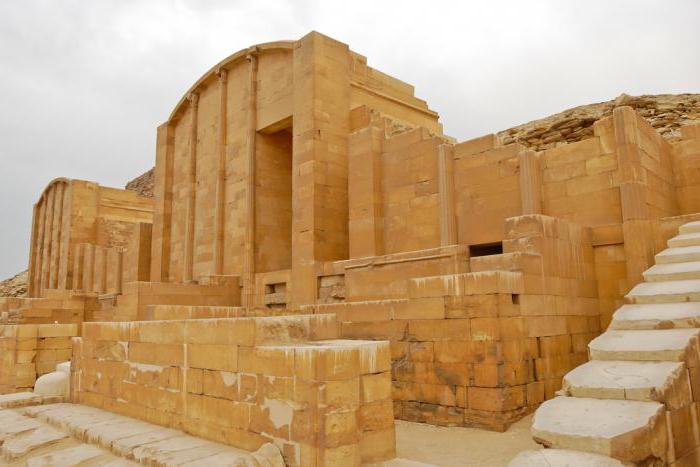
The step pyramid of Pharaoh Djoser is nestled on the edge of the plateau. The place for the majestic structure was not chosen by chance by its creator. Researchers are convinced that Imhotep was fascinated by the wonderful view of Memphis. It is interesting that before the construction of this structure, the Egyptian tombs of the kings were located only in locality, which was called Abydos.
The most convenient way to get to Saqqara is by signing up for an excursion, if tourists are not bothered by time constraints.
What is known about the creators of the pyramids?
The step pyramid of Pharaoh Djoser immortalized the Egyptian emperor, who did not distinguish himself in anything special during the years of his reign. The creator of the unique structure, Imhotep, has also gone down in history forever. This man was a universal scientist and served as a minister to the ruler of Egypt.
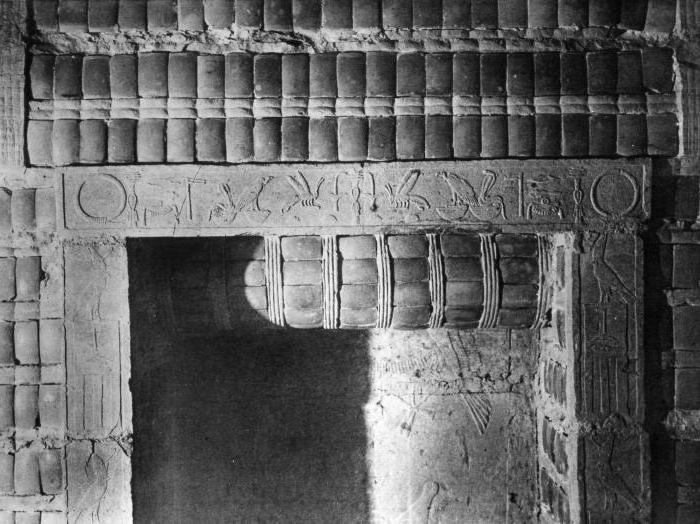
Imhotep managed to become the first architect whose name was carved on the statues of the emperor, and he is also mentioned in the funerary complex. History has failed to accurately establish the years of this man’s life, as well as the place of his burial. After leaving this world, the architect was deified; his contemporaries declared him the god of medicine. There are ancient religious buildings, named after Imhotep, in the old days they attracted the sick who prayed for healing. A figurine depicting the architect is currently among the exhibits of the Louvre.
Use of stone
The step pyramid of Djoser at Saqqara was the first building of this type in Egypt to use stone in its construction. Before the advent of Imhotep's brainchild, all tombs were built using raw bricks. Most of them disappeared before our era, since the material was not suitable for these purposes.
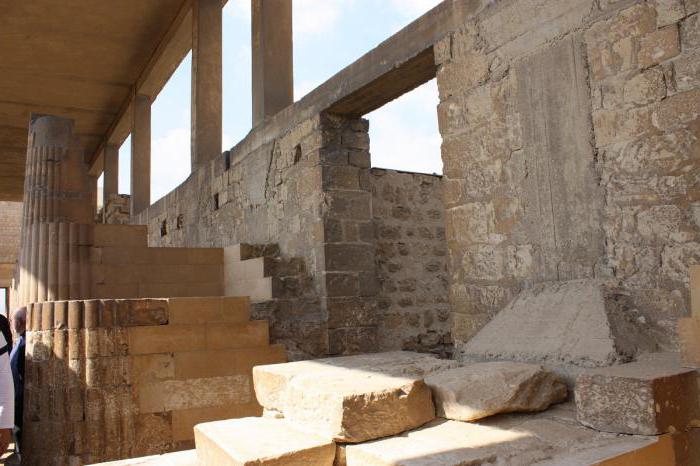
However, you should not blindly trust tour guides who insist that this is the first large stone structure on the planet. Previously, the French Barnenes was built; according to researchers, its age is over 6 thousand years.
Construction stages
Surprisingly, the step pyramid in Saqqara was built in 4 stages, which also became a kind of world record Ancient Egypt. Despite the state in which the structure is today, each stage of its construction is easy to trace even now. This is possible thanks to different masonry, chamber and tunnel configurations.
The history of the mysterious building began with the creation of a rectangular tomb. As mentioned above, the material for it was stone. However, the result was not satisfactory Egyptian pharaoh. As the researchers suggest, the problem was the modest size of the structure. The second stage is the increase in length and width of the rectangular structure.
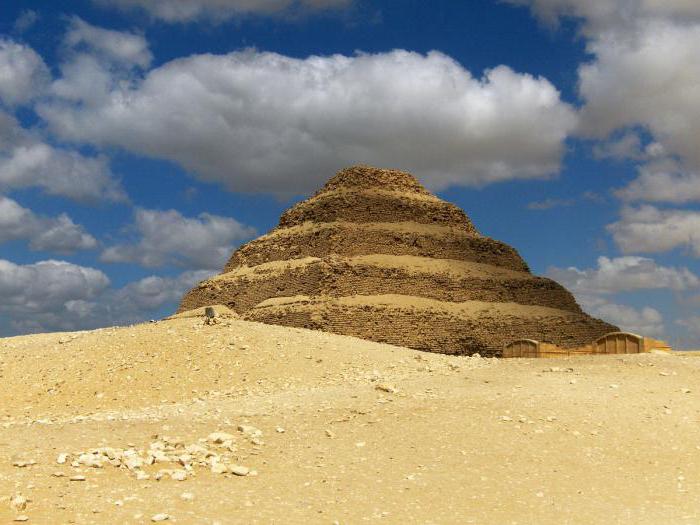
The step pyramid is what the building was like in the third stage. She acquired three additional superstructures, eventually acquiring four tiers. The pharaoh was again dissatisfied, so the tomb was expanded again, adding two upper tiers. The Egyptians would not have been able to achieve this using raw brick. It is not surprising that the use of stone became fashionable after the completion of the pyramid at Saqqara.
Technical details
The height of the six-step pyramid is about 60 meters. For comparison, the same figure for a building with 16 floors is no more than 43 meters. The base of the structure, erected by the will of Djoser, once measured 125 by 115 meters. The destructive influence of nature to which the structure has been subjected over the centuries has reduced its size.
Purpose
Traditionally, tombs contained exclusively the remains of Egyptian kings. The step pyramid of Djoser, a photo of which can be admired in this article, turned out to be revolutionary in this regard. The building became the last refuge not only for the ruler himself, but also for his children and wives.
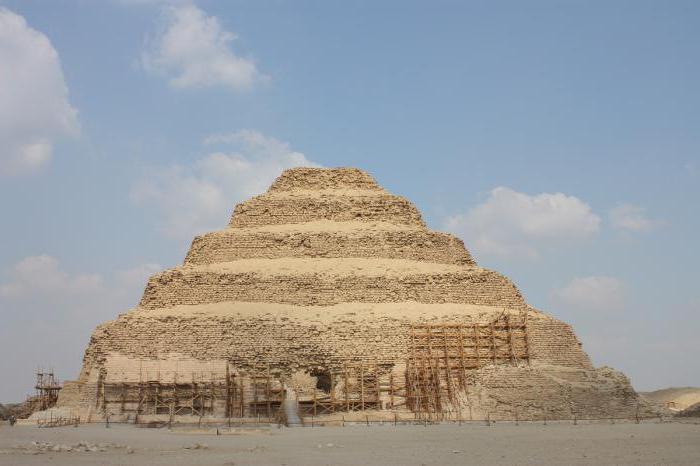
Historians have been unable to establish the exact number of members of the dynasty whose bones were left inside the pyramid after death. What is known is that there were more than a dozen of them. A curious discovery was the mines located on east side. Their depth is 32 meters, while the depth of the main shaft, which received the emperor’s body, does not exceed 28 meters.
Some researchers are convinced that the mysterious mines were prepared for Djoser's harem. If this theory is confirmed, it turns out that the number of “inhabitants” of the tomb went beyond a hundred. There are also people who claim that the mines were a place for treasure. Unfortunately, it is difficult to find out, since raids on the tomb’s valuables were carried out in ancient times.
Underground tunnels
The Pyramid of Djoser, created under the leadership of Imhotep, is not a comfortable place for walking. Once in the tunnels, the total length of which exceeds 5.5 km, you may not find a way out. For comparison: the tunnels of the tomb of Cheops occupy no more than a few hundred meters.
What is inside?
Often travelers who manage to see majestic pyramids from the inside, they feel deceived. They find no colorful frescoes or mysterious inscriptions. The Step Pyramid of Djoser, which is now extremely difficult to find inside, will certainly not force its visitors to experience such disappointment.
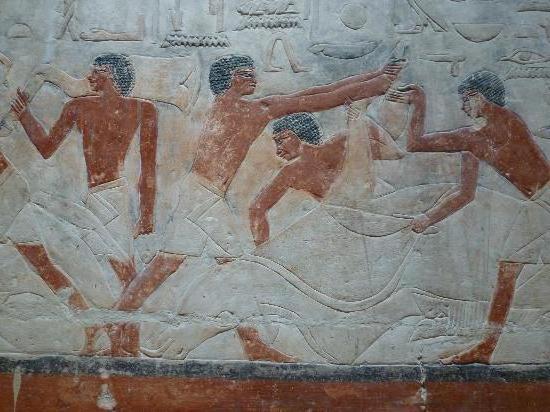
Tourists will be fascinated when they find themselves in a burial chamber, the walls of which are decorated with multi-colored tiles (green, turquoise). The products used during the times of Ancient Egypt are visually similar to the ceramic tiles of our day. Of course, modern materials would hardly survive 4,600 years, while the tiles created by ancient people were well preserved.
The bas-reliefs decorating the walls, which depict images, are also captivating. Egyptian gods. They have survived to this day in better condition than tiles, because they are located on the surface of granite blocks. Excavations also helped uncover the remains of a sarcophagus belonging to a powerful pharaoh. In addition, inside you can admire the images five-pointed star. The Egyptians in those days associated this symbol with the abode of the dead.
You can also admire three bas-relief paintings with portraits of Djoser. The ruler of Egypt was depicted during his participation in religious rites, the head of the pharaoh is crowned with a traditional crown.
Tourist information
Some disappointment is caused by the state in which the step pyramid of Djoser is now located. The architect managed to create a reliable building that has survived to this day, but weather troubles and the actions of vandals significantly affected it. appearance. Not surprisingly, government decree prohibits free entry into the attraction. Reconstruction work is currently underway, so the monument is constantly surrounded by scaffolding.
Theoretically, it is possible to see what Djoser's pyramid is like from the inside. To do this, you will need to obtain permission from the Egyptian Antiquities Service, but this will take a very long time. Visiting Saqqara is available daily; you can enter the necropolis from 8 a.m. to 4 p.m. The exception is those days when the complex is closed to provide working conditions for archaeologists. Therefore, before your trip, it is worth checking whether Saqqara is currently open to tourists.
When planning to see Imhotep’s brainchild with your own eyes, we must not forget about the weather conditions. Spending several hours under the sun without being able to shelter inside a building is very difficult.
- In contact with 0
- Google+ 0
- OK 0
- Facebook 0

